
(A) CAD layout of Foldscope paper components on an A4 sheet. (B) Schematic of an assembled Foldscope illustrating panning, and (C) cross-sectional view illustrating flexure-based focusing. (D) Foldscope components and tools used in the assembly, including Foldscope paper components, ball lens, button-cell battery, surface-mounted LED, switch, copper tape and polymeric filters. (E) Different modalities assembled from colored paper stock. (F) Novice users demonstrating the technique for using the Foldscope. (G) Demonstration of the field-rugged design, such as stomping under foot.
Scientific inquiry —looking at the world and asking questions about what we observe—is a natural human behavior. Why is the sky blue? What would happen if I did this Mom? Ask any grade school teacher. Kids do science naturally. They are not afraid of questions. They are not afraid of nature. They are not afraid of experiments and data collection.
One other things kids do really well is: fold paper. I never cease to be amazed at the elaborate fortune tellers, hoppers, boats, hats and other creations that my daughter and her friends make at a moment’s notice out of virtually any scrap of paper they can find.
Recently members of the Prakash Lab at Standford University announced the Foldscope: an optical microscope that is printed and folded from a single flat sheet of paper. These microscopes, which can provide magnification of up to 2000X, can be produced for less than $1.00/each. Furthermore these scopes weigh less than 10g (a couple of coins), require no external power source, can be dropped from 3-stories without damage, and can even be stepped on.
These characteristics make the Foldscope ideal for field work, particularly in remote locations where access to power and other resources is difficult. Prakash and colleagues have published their work in a PLOS One paper and have demonstrated many uses for these Foldscopes including high-resolution brightfield microscopy, fluorescence microscopy, and darkfield microscopy. Continue reading “Fold It Up and Discover a Whole New World”
